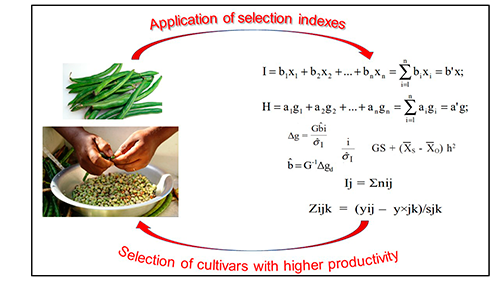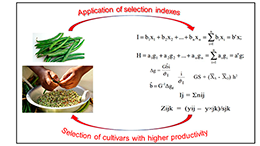Biometric genetics in Cowpea beans (Vigna unguiculata (L.) Walp) II: estimates of genetic gains through selection indices
DOI:
https://doi.org/10.48162/rev.39.103Keywords:
Selection indices, Genetic improvement, Simultaneous selection, Productivity, correlated response, Vigna unguiculata (L.) Walp.Abstract

Low cowpea productivity (Vigna unguiculata (L.) Walp) in the semi-arid region of Paraíba is due, among other factors, to poor-quality cultivars. This research tested biometric models intending to increase productivity of superior cultivars with the following objectives: i. Estimate genetic gains in production components; ii. Identify the selection index model providing the greatest gains through simultaneously selecting a set of variables, and iii. Select cultivars with higher productivity. The experiment was carried out in the experimental field of the Agrifood Science and Technology Center of the Federal University of Campina Grande. Eight cultivars and 13 variables were evaluated. Data were subjected to ANOVA and means were grouped using the Scott and Knott test. Genetic gains were estimated by correlated response, classic selection index, rank sum and index based on desired gains. Direct selection of the secondary pod yield component provides significant genetic gains in main grain yield. Among the methodologies used, the classic selection index provided greater distribution of genetic gains for main grain yield and primary production components. These results allow concluding that Costela de vaca, BRS Marataoã and Paulistinha cultivars should be selected for cultivation and commercial exploitation in the semiarid region of Paraíba.
Highlights:
- Direct selection of the secondary pod yield component provides significant genetic gains in main grain yield.
- The classic selection index provided greater distribution of genetic gains for main grain yield and primary production components.
- Cultivars were selected for cultivation and commercial exploitation in the semi-arid region of Paraíba.
Downloads

Downloads
Published
How to Cite
Issue
Section
License
Copyright (c) 2018 Revista de la Facultad de Ciencias Agrarias UNCuyo

This work is licensed under a Creative Commons Attribution-NonCommercial-ShareAlike 3.0 Unported License.
Aquellos autores/as que tengan publicaciones con esta revista, aceptan las Políticas Editoriales.










.jpg)




